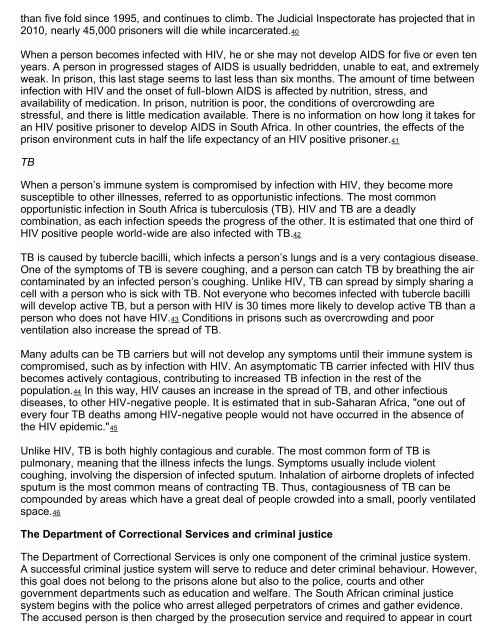prison privatisation in south africa issues, challenges and ...
prison privatisation in south africa issues, challenges and ...
prison privatisation in south africa issues, challenges and ...
Create successful ePaper yourself
Turn your PDF publications into a flip-book with our unique Google optimized e-Paper software.
than five fold s<strong>in</strong>ce 1995, <strong>and</strong> cont<strong>in</strong>ues to climb. The Judicial Inspectorate has projected that <strong>in</strong><br />
2010, nearly 45,000 <strong>prison</strong>ers will die while <strong>in</strong>carcerated.40<br />
When a person becomes <strong>in</strong>fected with HIV, he or she may not develop AIDS for five or even ten<br />
years. A person <strong>in</strong> progressed stages of AIDS is usually bedridden, unable to eat, <strong>and</strong> extremely<br />
weak. In <strong>prison</strong>, this last stage seems to last less than six months. The amount of time between<br />
<strong>in</strong>fection with HIV <strong>and</strong> the onset of full-blown AIDS is affected by nutrition, stress, <strong>and</strong><br />
availability of medication. In <strong>prison</strong>, nutrition is poor, the conditions of overcrowd<strong>in</strong>g are<br />
stressful, <strong>and</strong> there is little medication available. There is no <strong>in</strong>formation on how long it takes for<br />
an HIV positive <strong>prison</strong>er to develop AIDS <strong>in</strong> South Africa. In other countries, the effects of the<br />
<strong>prison</strong> environment cuts <strong>in</strong> half the life expectancy of an HIV positive <strong>prison</strong>er.41<br />
TB<br />
When a person’s immune system is compromised by <strong>in</strong>fection with HIV, they become more<br />
susceptible to other illnesses, referred to as opportunistic <strong>in</strong>fections. The most common<br />
opportunistic <strong>in</strong>fection <strong>in</strong> South Africa is tuberculosis (TB). HIV <strong>and</strong> TB are a deadly<br />
comb<strong>in</strong>ation, as each <strong>in</strong>fection speeds the progress of the other. It is estimated that one third of<br />
HIV positive people world-wide are also <strong>in</strong>fected with TB.42<br />
TB is caused by tubercle bacilli, which <strong>in</strong>fects a person’s lungs <strong>and</strong> is a very contagious disease.<br />
One of the symptoms of TB is severe cough<strong>in</strong>g, <strong>and</strong> a person can catch TB by breath<strong>in</strong>g the air<br />
contam<strong>in</strong>ated by an <strong>in</strong>fected person’s cough<strong>in</strong>g. Unlike HIV, TB can spread by simply shar<strong>in</strong>g a<br />
cell with a person who is sick with TB. Not everyone who becomes <strong>in</strong>fected with tubercle bacilli<br />
will develop active TB, but a person with HIV is 30 times more likely to develop active TB than a<br />
person who does not have HIV.43 Conditions <strong>in</strong> <strong>prison</strong>s such as overcrowd<strong>in</strong>g <strong>and</strong> poor<br />
ventilation also <strong>in</strong>crease the spread of TB.<br />
Many adults can be TB carriers but will not develop any symptoms until their immune system is<br />
compromised, such as by <strong>in</strong>fection with HIV. An asymptomatic TB carrier <strong>in</strong>fected with HIV thus<br />
becomes actively contagious, contribut<strong>in</strong>g to <strong>in</strong>creased TB <strong>in</strong>fection <strong>in</strong> the rest of the<br />
population.44 In this way, HIV causes an <strong>in</strong>crease <strong>in</strong> the spread of TB, <strong>and</strong> other <strong>in</strong>fectious<br />
diseases, to other HIV-negative people. It is estimated that <strong>in</strong> sub-Saharan Africa, "one out of<br />
every four TB deaths among HIV-negative people would not have occurred <strong>in</strong> the absence of<br />
the HIV epidemic."45<br />
Unlike HIV, TB is both highly contagious <strong>and</strong> curable. The most common form of TB is<br />
pulmonary, mean<strong>in</strong>g that the illness <strong>in</strong>fects the lungs. Symptoms usually <strong>in</strong>clude violent<br />
cough<strong>in</strong>g, <strong>in</strong>volv<strong>in</strong>g the dispersion of <strong>in</strong>fected sputum. Inhalation of airborne droplets of <strong>in</strong>fected<br />
sputum is the most common means of contract<strong>in</strong>g TB. Thus, contagiousness of TB can be<br />
compounded by areas which have a great deal of people crowded <strong>in</strong>to a small, poorly ventilated<br />
space.46<br />
The Department of Correctional Services <strong>and</strong> crim<strong>in</strong>al justice<br />
The Department of Correctional Services is only one component of the crim<strong>in</strong>al justice system.<br />
A successful crim<strong>in</strong>al justice system will serve to reduce <strong>and</strong> deter crim<strong>in</strong>al behaviour. However,<br />
this goal does not belong to the <strong>prison</strong>s alone but also to the police, courts <strong>and</strong> other<br />
government departments such as education <strong>and</strong> welfare. The South African crim<strong>in</strong>al justice<br />
system beg<strong>in</strong>s with the police who arrest alleged perpetrators of crimes <strong>and</strong> gather evidence.<br />
The accused person is then charged by the prosecution service <strong>and</strong> required to appear <strong>in</strong> court
















